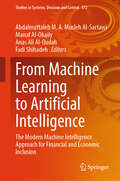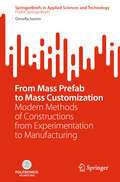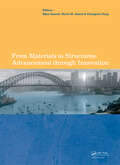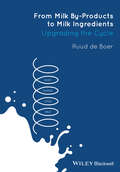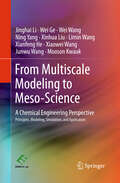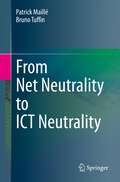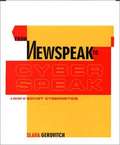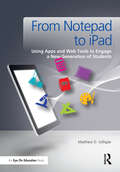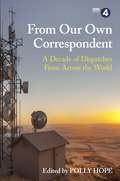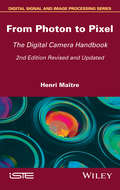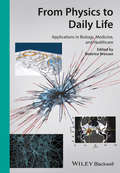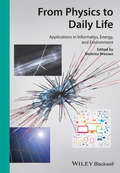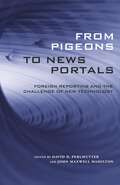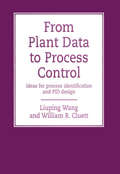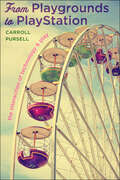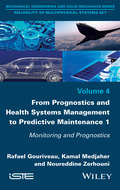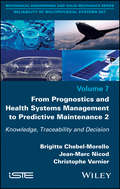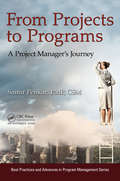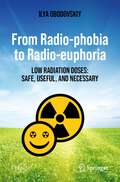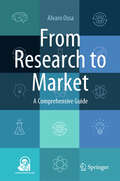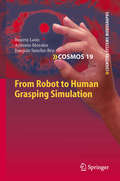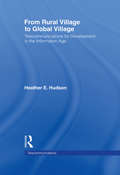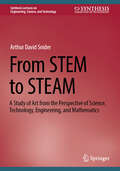- Table View
- List View
From Machine Learning to Artificial Intelligence: The Modern Machine Intelligence Approach for Financial and Economic Inclusion (Studies in Systems, Decision and Control #572)
by Abdalmuttaleb M. A. Musleh Al-Sartawi Anas Ali Al-Qudah Fadi Shihadeh Manaf Al-OkailyThe world is on a cusp of something great. Technology has advanced from solving simple issues to complex issues in both human life and other aspects such as social, economic, and environmental issues. The significance of machine intelligence as a tool to propel human as well as economic development is an important and hot topic today. This book is about how modern machine intelligence, AI, and machine learning applications can be used by governments and firms for financial and economic inclusion, as well as for providing solutions to bridge the digital divide. It aims to cover philosophical discussions, frameworks, and applications on central topics in machine intelligence, deep learning, mesh networks, frugal engineering, frugal innovation, blockchain technology, alternate networks, and intelligent digital financial inclusion system architectures. This book also aims to discuss the initiatives, policies, strategies, and governance issues related to furnishing technologies for technology access, financial inclusion and in turn economic growth. Financial inclusion is defined as the proportion of people and corporations that use financial services. It further describes the fair, equal, and attainable access to financial services (Rawat et al., 2023). Financial inclusion is key to economic inclusion and economic growth as it enables the poor to improve their lives. Chapters in the book will improve our understanding of the advances and challenges of applying machine intelligence for financial inclusion and economic growth in different contexts including financial markets, governments, and corporations in both developing and developed countries. Access to financial services is essential to development efforts of markets, economies and eventually societies. Hence, in this context, financial inclusion can be explained as the process of ensuring that individuals particular impoverished people have access to essential financial services in the formal financial sector. Financial inclusion, recently, has been receiving traction from scholars and policymakers whereby it is one of the major strategies used by economies and societies in achieving UN’s sustainable development goals. Rawat et al. (2023) argues that it is vital to increase the use of “low-cost digital methods” for the economically marginalized and under-served people and sectors. There is a need for financial inclusion for the rapidly dynamic Industry 4.0. Therefore, linking technology, more particularly machine intelligence with financial inclusion and technology access is quite crucial given the current technological environment. Additionally, financial inclusion helps in enhancing the level of economic and social inclusion in many societies and developing countries as well as help in reducing poverty levels. Policy makers in several countries continue to commit significant resources and technologies to increase the level of financial inclusion in their countries to reduce financial exclusion. In developing countries, financial inclusion remains below potential in part due to the digital divide, limited technology access and the challenge for financial institutions in developing products for the low-income mass market (Hook IV, 2019; Marimuthu et al., 2022). These matters are important topics to be researched and discussed, especially with the advancement of technology such as artificial intelligence, machine learning, blockchain, business intelligence, online education, in the current post-pandemic environment which catalysed these digital transformations. Therefore, this book has been proposed to discuss a very important and emerging topics which contributes significantly to policy and the SDGs in the digital economy.
From Mass Prefab to Mass Customization: Modern Methods of Constructions from Experimentation to Manufacturing (SpringerBriefs in Applied Sciences and Technology)
by Ornella IuorioThis book provides an overview of the latest innovations in prefabrication. It analyzes how digital, material, and process innovations are transforming the mass prefabrication of homes, schools, and offices into mass customization. It provides an understanding of available manufacturing processes, including distributed ownership of manufacturing, platform approaches, and robotics. It discusses how the integration of cutting-edge advanced construction techniques, coupled with robotic manufacturing and assembly from the earliest stages of building system design, has the potential to unlock new formal and technical paradigms. Investigating the impact of prefab in the context of climate emergency, the book analyzes the capacity and shortfall in delivering net zero emissions. It discusses the opportunities that Modern Methods of Construction provide to enable the transition towards circular constructions, from reuse to retrofitting. Including the users' experience, it demonstrates the importance of developing methodologies for capturing users' occupancy evaluation, as a means for understanding real performances, benchmarking indicators, and tuning systems to target the long-term well-being of the occupants. Referring to a plethora of emblematic cases, this work demonstrates the importance of investing in research and development to optimize construction systems, reduce material use, facilitate lean construction, advance mechanical and environmental performances, and move toward circular systems to close the loop. This book is aimed at practitioners, architects, technologists, researchers, and students in architectural engineering.
From Materials to Structures: Advancement through Innovation
by Chongmin Song Bijan Samali Mario M. AttardFrom Materials to Structures: Advancement through Innovation is a collection of peer-reviewed papers presented at the 22nd Australasian Conference on the Mechanics of Structures and Materials (ACMSM22) held in Sydney Australia, from 11-14 December 2012 by academics, researchers and practising engineers mainly from Australasia and the Asia-Pacific r
From Milk By-Products to Milk Ingredients: Upgrading the Cycle
by Ruud de BoerMilk is a complex substance, and a variety of constituents can be extracted from it for use as ingredients in other foods. The main ingredients from milk are milk fat, cheese and serum, but this range is continually expanding as food companies, dairies and dairy scientists seek to utilize as many raw materials and by-products as possible, to reduce waste, maximize efficiency, and increase productivity. Ingredients from Milk is a concise, fresh approach to ingredients derived from milk, containing guidance and new techniques for dairy industry professionals and scientists. has a structure is designed to mirror the process of extracting ingredients from milk, beginning with the basic concepts and following through the processes until finally arriving at the consumer products which constitute the end uses of ingredients from milk. This book is primarily targeted at the dairy industry, but also provides a valuable insight for academics and students seeking an industry perspective.
From Models to Simulations (History and Philosophy of Technoscience)
by Franck VarenneThis book analyses the impact computerization has had on contemporary science and explains the origins, technical nature and epistemological consequences of the current decisive interplay between technology and science: an intertwining of formalism, computation, data acquisition, data and visualization and how these factors have led to the spread of simulation models since the 1950s. Using historical, comparative and interpretative case studies from a range of disciplines, with a particular emphasis on the case of plant studies, the author shows how and why computers, data treatment devices and programming languages have occasioned a gradual but irresistible and massive shift from mathematical models to computer simulations.
From Multiscale Modeling to Meso-Science
by Wei Wang Limin Wang Jinghai Li Junwu Wang Mooson Kwauk Ning Yang Wei Ge Xianfeng He Xiaowei Wang Xinhua LiuMultiscale modeling is becoming essential for accurate, rapid simulation in science and engineering. This book presents the results of three decades of research on multiscale modeling in process engineering from principles to application, and its generalization for different fields. This book considers the universality of meso-scale phenomena for the first time, and provides insight into the emerging discipline that unifies them, meso-science, as well as new perspectives for virtual process engineering. Multiscale modeling is applied in areas including: multiphase flow and fluid dynamicschemical, biochemical and process engineeringmineral processing and metallurgical engineeringenergy and resourcesmaterials science and engineeringJinghai Li is Vice-President of the Chinese Academy of Sciences (CAS), a professor at the Institute of Process Engineering, CAS, and leader of the EMMS (Energy-minimizing multiscale) Group. Wei Ge, Wei Wang, Ning Yang and Junwu Wang are professors at the EMMS Group, part of the Institute of Process Engineering, CAS. Xinhua Liu, Limin Wang, Xianfeng He and Xiaowei Wang are associate professors at the EMMS Group, part of the Institute of Process Engineering, CAS. Mooson Kwauk is an emeritus director of the Institute of Process Engineering, CAS, and is an advisor to the EMMS Group.
From Net Neutrality to ICT Neutrality
by Patrick Maillé Bruno TuffinThis book discusses the pros and cons of information and communication (ICT) neutrality. It tries to be as objective as possible from arguments of proponents and opponents, this way enabling readers to build their own opinion. It presents the history of the ongoing network neutrality debate, the various concepts it encompasses, and also some mathematical developments illustrating optimal strategies and potential counter-intuitive results, then extends the discussion to connected ICT domains. The book thus touches issues related to history, economics, law, networking, and mathematics. After an introductory chapter on the history of the topic, chapter 2 surveys and compares the various laws in place worldwide and discusses some implications of heterogeneous rules in several regions. Next, chapter 3 details the arguments put forward by the participants of the net neutrality debate. Chapter 4 then presents how the impact of neutral or non-neutral behaviors can be analyzed mathematically, with sometimes counter-intuitive results, and emphasizes the interest of modeling to avoid bad decisions. Chapter 5 illustrates that content providers may not always be on the pro-neutrality side, as there are situations where they may have an economic advantage with a non-neutral situation, e.g. when they are leaders on a market and create barriers to entry for competitors. Another related issue is covered in chapter 6, which discusses existing ways for ISPs to circumvent the packet-based rules and behave non-neutral without breaking the written law. Chapter 7 gives more insight on the role and possible non-neutral behavior of search engines, leading to another debate called the search neutrality debate. Chapter 8 focuses on e-commerce platforms and social networks, and investigates how they can influence users’ actions and opinions. The issue is linked to the debate on the transparency of algorithms which is active in Europe especially. Chapter 9 focuses on enforcing neutrality in practice through measurements: indeed, setting rules requires monitoring the activity of ICT actors in order to sanction non-appropriate behaviors and be proactive against new conducts. The chapter explains why this is challenging and what tools are currently available. Eventually, Chapter 10 briefly concludes the presentation and opens the debate.
From Newspeak to Cyberspeak: A History of Soviet Cybernetics
by Slava GerovitchSlava argues that Soviet cybernetics was not just an intellectual trend but a social movement for radical reform in science and society as a whole. Followers of cybernetics viewed computer simulation as a universal method of problem solving
From Notepad to iPad: Using Apps and Web Tools to Engage a New Generation of Students
by Matthew GillispieThis book is a one-stop-shop for secondary teachers looking to use iPads effectively in the classroom. The author provides a clear and practical overview of how to implement the technology, manage it, and use it successfully. Each chapter is full of tips and engaging classroom activities. Teachers at all levels of experience and comfort with technology will benefit from the ideas and resources in this book. Special Features: Screen shots and other visuals to help you use the recommended apps and websites Strategies for managing technology use in the classroom Lesson plans that effectively teach literacy and content through the use of technology Connections to the Common Core State Standards Samples of student work using iPads Rubrics for a variety of suggested assignments
From Our Own Correspondent: Dispatches of a Decade from Across the World
by Polly Hope<p>For more than sixty-five years on the air, From Our Own Correspondent has been one of BBC Radio's flagship programmes. It has taken listeners to parts of the world where they have never gone, and perhaps never would: war zones, refugee camps, elite universities, space stations, spy academies and lions' dens of all sorts. Its dispatches introduce audiences to people they might never expect to meet - kingpins, revolutionaries, assassins and outcasts. It has always relied on the power of personal testimony, with its contributors not merely reporting the news, but sharing what they found out along the way, and how it felt. Its correspondents often relate the unexpected: the day they visited the town that is crazy about trout fishing, attended a forty-course Chinese banquet, experienced zero gravity on a flight with Russian cosmonauts, went mud wrestling in Turkey or ballroom dancing in Cameroon.<p> <p>Themed by continent and region, From Our Own Correspondent brings together the most compelling stories of the past ten years. It is a perfect primer for the understanding of the modern world.<p>
From Photon to Pixel: The Digital Camera Handbook
by Henri MaîtreThis second edition of the fully revised and updated From Photon to Pixel presents essential elements in modern digital photographic devices. Our universal infatuation with photography profoundly affects its usage and development.While some sides of photographic “culture” remain wholly unchanged – art photography, journalistic and advertising photography, scientific photography, etc. – new facets emerge: leisure or travel photography, everyday life photography, anecdotal, observational or unusual photography, and microcosm, or micro-community, photography with its culmination in the narcissistic selfie. These new forms combine an often simplified manner of photographing and modern means of instantaneous, remote and mass communication. This book does not extend into the sociological study of photography, instead it explains how the digital camera works by examining in detail each of the components that constitutes it to provide the reader with a preliminary guide into the inner workings of this device.
From Physics to Daily Life
by Beatrice BressanBeatrice Bressan brings together a number of outstanding examples of successful cross-disciplinary technology transfer originating in fundamental physics research, which dramatically impacted scientific progress in areas which changed modern society. Many of them were developed at CERN, a hotbed of fundamental inventions in particle physics. This book deals with breakthrough developments being applied in the world of IT, consumer electronics, aviation, and material sciences.Additional sections of the book deal with knowledge management and technology transfer including their economic aspects. While each chapter has been drafted by an expert in the field, the editor has carefully edited the whole to ensure a coherent overall structure.A must-have for policy makers, technology companies, investors, strategic planners in research and technology, as well as attractive reading for the research community.
From Physics to Daily Life: Applications in Informatics, Energy, and Environment
by Beatrice BressanBeatrice Bressan brings together a number of outstanding examples of successful cross-disciplinary technology transfer originating in fundamental physics research, which dramatically impacted scientific progress in areas which changed modern society. Many of them were developed at CERN, a hotbed of fundamental inventions in particle physics. This book deals with breakthrough developments being applied in the world of IT, consumer electronics, aviation, and material sciences. Additional sections of the book deal with knowledge management and technology transfer including their economic aspects. While each chapter has been drafted by an expert in the field, the editor has carefully edited the whole to ensure a coherent overall structure. A must-have for policy makers, technology companies, investors, strategic planners in research and technology, as well as attractive reading for the research community.
From Pigeons to News Portals: Foreign Reporting and the Challenge of New Technology (Media & Public Affairs)
by David D. Perlmutter John Maxwell HamiltonEver since the invention of the telegraph, journalists have sought to remove the barriers of time and space. Today, we readily accept that reporters can jet quickly to a distant location and broadcast instantly from a satellite-connected, video-enabled cell phone hanging from their belts. But now that live news coverage is possible from virtually anywhere, is foreign correspondence better? And what are the implications of recent changes in journalistic technology for policy makers and their constituents? In From Pigeons to News Portals, edited by David D. Perlmutter and John Maxwell Hamilton, scholars and journalists survey, probe, and demystify the new foreign correspondence that has emerged from rapidly changing media technology. These distinguished authors challenge long-held beliefs about foreign news coverage, not the least of which is whether, in our interconnected world, such a thing as "foreign news" even exists anymore. Essays explore the ways people have used new media technology -- from satellites and cell phones to the Internet -- to affect content, delivery modes, and amount and style of coverage. They examine the ways in which speedy reporting conflicts with in-depth reporting, the pros and cons of "parachute" journalism, the declining dominance of mainstream media as a source of foreign news, and the implications of this new foreign correspondence for foreign policy. Entertainment media such as film, television, and video gaming form worldwide opinions about America, often in negative ways. Meanwhile, live reporting abroad is both a blessing and curse for foreign policy makers. Because foreign news is so vital to effective policy making and citizenship, we imperil our future by failing to understand the changes technology brings and how we can wrest the best practice out of those changes. This provocative volume offers valuable insights and analyses to help us better understand the evolving state of foreign news.
From Plant Data to Process Control: Ideas for Process Identification and PID Design
by Liuping WangProcess engineering spans industrial applications in the manufacturing sector from petrochemical to polymer to mineral production. From Plant Data to Process Control covers the most up-to-date techniques and algorithms in the area of process identification (PID) and process control, two key components of process engineering, essential for optimizin
From Playgrounds to PlayStation: The Interaction of Technology and Play
by Carroll PursellHow technology shapes play in America—and vice versa.In this romp through the changing landscape of nineteenth- and twentieth-century American toys, games, hobbies, and amusements, senior historian of technology Carroll Pursell poses a simple but interesting question: What can we learn by studying the relationship between technology and play? From Playgrounds to PlayStation explores how play reflects and drives the evolution of American culture. Pursell engagingly examines the ways in which technology affects play and play shapes people. The objects that children (and adults) play with and play on, along with their games and the hobbies they pursue, can reinforce but also challenge gender roles and cultural norms. Inventors—who often talk about "playing" at their work, as if motivated by the pure fun of invention—have used new materials and technologies to reshape sports and gameplay, sometimes even crafting new, extreme forms of recreation, but always responding to popular demand.Drawing from a range of sources, including scholarly monographs, patent records, newspapers, and popular and technical journals, the book covers numerous modes and sites of play. Pursell touches on the safety-conscious playground reform movement, the dazzling mechanical innovations that gave rise to commercial amusement parks, and the media's colorful promotion of toys, pastimes, and sporting events. Along the way, he shows readers how technology enables the forms, equipment, and devices of play to evolve constantly, both reflecting consumer choices and driving innovators and manufacturers to promote toys that involve entirely new kinds of play—from LEGOs and skateboards to beading kits and videogames.
From Playgrounds to Playstation: The Interaction of Technology & Play
by Carroll PursellThis “engaging social history of play” explores how technology and culture have shaped toys, games, and leisure—and vice versa (Choice).In this romp through the changing landscape of nineteenth- and twentieth-century American toys, games, hobbies, and amusements, technology historian Carroll Pursell poses a simple but interesting question: What can we learn by studying the relationship between technology and play?From Playgrounds to PlayStation explores how play reflects and drives the evolution of American culture. Pursell engagingly examines the ways in which technology affects play and play shapes people. The objects that children (and adults) play with and play on, along with their games and the hobbies they pursue, can reinforce but also challenge gender roles and cultural norms. Inventors—who often talk about “playing” at their work, as if motivated by the pure fun of invention—have used new materials and technologies to reshape sports and gameplay, sometimes even crafting new, extreme forms of recreation, but always responding to popular demand.Drawing from a range of sources, including scholarly monographs, patent records, newspapers, and popular and technical journals, the book covers numerous modes and sites of play. Pursell touches on the safety-conscious playground reform movement, the dazzling mechanical innovations that gave rise to commercial amusement parks, and the media’s colorful promotion of toys, pastimes, and sporting events. Along the way, he shows readers how technology enables the forms, equipment, and devices of play to evolve constantly, both reflecting consumer choices and driving innovators and manufacturers to promote toys that involve entirely new kinds of play—from LEGOs and skateboards to beading kits and videogames.
From Prognostics and Health Systems Management to Predictive Maintenance 1: Monitoring and Prognostics
by Rafael Gouriveau Noureddine Zerhouni Kamal MedjaherThis book addresses the steps needed to monitor health assessment systems and the anticipation of their failures: choice and location of sensors, data acquisition and processing, health assessment and prediction of the duration of residual useful life. The digital revolution and mechatronics foreshadowed the advent of the 4.0 industry where equipment has the ability to communicate. The ubiquity of sensors (300,000 sensors in the new generations of aircraft) produces a flood of data requiring us to give meaning to information and leads to the need for efficient processing and a relevant interpretation. The process of traceability and capitalization of data is a key element in the context of the evolution of the maintenance towards predictive strategies.
From Prognostics and Health Systems Management to Predictive Maintenance 2: Knowledge, Traceability and Decision
by Brigitte Chebel-Morello Christophe Varnier Jean-Marc NicodThis book is the second volume in a set of books dealing with the evolution of technology, IT and organizational approaches and what this means for industrial equipment. The authors address this increasing complexity in two parts, focusing specifically on the field of Prognostics and Health Management (PHM). Having tackled the PHM cycle in the first volume, the purpose of this book is to tackle the other phases of PHM, including the traceability of data, information and knowledge, and the ability to make decisions accordingly. The book concludes with a summary analysis and perspectives regarding this emerging domain, since without traceability, knowledge and decision, any prediction of the health state of a system cannot be exploited.
From Projects to Programs: A Project Manager's Journey (Best Practices in Portfolio, Program, and Project Management #8)
by Samir PenkarThis book tells the story of an up-and-coming project manager that's been handed a large program to lead. Readers follow along as she struggles, leads, stumbles, and grows into the program manager role. Introducing key program management concepts throughout, the book provides a backstage view into the workings of program management, program organization, team dynamics, and the skills required to manage programs. Told through the eyes of a program manager, readers will experience the ins and outs of program management.
From Radio-phobia to Radio-euphoria: Low Radiation Doses: Safe, Useful, and Necessary (Springer Praxis Books)
by Ilya ObodovskiyThis book gives a detailed discussion of the initial enthusiasm triggered by the discovery of x-rays and radioactive radiation which later turned into fear and repulsion in a significant part of the global population up to the 21st century.After a historical review, the author discusses the effect of ionizing radiation on living cells, tissues and organisms. He then describes the relationship between the dose of radiation and the effect it produces. He shows how the dose-effect dependence is measured and what models of describing such dependences are used. He also discusses how radiation acts on living organisms: disorders in the genetic apparatus, mutation formation and so on. The book also includes detailed descriptions of the results of numerous health studies of large groups of people who, for one reason or another, were exposed to low doses of ionizing radiation, including those that significantly exceed the natural radiation background. The author concludes that low doses of radiation are safe and can even be beneficial (as known from medical radiation treatment); and also that the natural radiation background is necessary for the normal growth and development and well-being of a living organism. The author also discusses cases and effects of large doses, arguing, however, that dangerous doses of radiation are very unlikely. This book challenges radio-phobia. It not only offers arguments helping to overcome an unreasonable fear but, based on the latest understanding of science, argues to gradually move back, not to the former radio-euphoria, but to a new, conscious attitude towards radiation.
From Research to Market: A Comprehensive Guide
by Alvaro OssaUnlock the secrets to transforming research into impactful products and services that reach the market. This book is a vital resource for anyone involved in the journey from academia to commercialization. It outlines the main stages and key milestones of technology transfer in a clear and engaging manner, featuring real-world examples of successful university research outcomes. Analyse the circumstances behind their success and learn the essential steps for a successful technology transfer process. Designed as a go-to reference for researchers, doctoral and master's students, scientific entrepreneurs, and academics focused on innovation and entrepreneurship, this book is also invaluable for technology managers at universities, research centres, and public agencies. Enhance your understanding of technology transfer and gain practical knowledge to navigate this complex field successfully.
From Robot to Human Grasping Simulation
by Beatriz León Antonio Morales Joaquín Sancho-BruThe human hand and its dexterity in grasping and manipulating objects are some of the hallmarks of the human species. For years, anatomic and biomechanical studies have deepened the understanding of the human hand's functioning and, in parallel, the robotics community has been working on the design of robotic hands capable of manipulating objects with a performance similar to that of the human hand. However, although many researchers have partially studied various aspects, to date there has been no comprehensive characterization of the human hand's function for grasping and manipulation of everyday life objects. This monograph explores the hypothesis that the confluence of both scientific fields, the biomechanical study of the human hand and the analysis of robotic manipulation of objects, would greatly benefit and advance both disciplines through simulation. Therefore, in this book, the current knowledge of robotics and biomechanics guides the design and implementation of a simulation framework focused on manipulation interactions that allows the study of the grasp through simulation. As a result, a valuable framework for the study of the grasp, with relevant applications in several fields such as robotics, biomechanics, ergonomics, rehabilitation and medicine, has been made available to these communities.
From Rural Village to Global Village: Telecommunications for Development in the Information Age (LEA Telecommunications Series)
by Heather E. HudsonFrom Rural Village to Global Village: Telecommunications for Development in the Information Age examines the role of information and communication technologies (ICTs) on both the macro level--societal, socio-economic, and governmental--and sector level--education, health, agriculture, entrepreneurship--emphasizing rural and developing regions. Author Heather E. Hudson examines the potential impact of ICTs by reviewing the existing research and adding her own findings from extensive fieldwork in ICT planning and evaluation. The volume includes case studies demonstrating innovative applications of ICTs plus chapters on evaluation strategies and appropriate technologies. She also analyzes the policy issues that must be addressed to facilitate affordable ICT access in rural and developing regions. This discussion relates to the larger “digital divide” issue, and the impact that access to communication technology--or the lack of it--has on communities and societies. This comprehensive volume is a valuable resource for scholars, professionals, researchers, and students in telecommunications law and policy, media economics, international communication, and communication and development fields. It is also suitable for use as an advanced-level text in these areas.
From STEM to STEAM: A Study of Art from the Perspective of Science, Technology, Engineering, and Mathematics (Synthesis Lectures on Engineering, Science, and Technology)
by Arthur David SniderThis book provides readers with an introductory overview of art from the perspective of science, technology, engineering, and mathematics. The author utilizes well-known and important works of art to demonstrate how STEM concepts apply to them. The book’s examples include a structural analysis of Michelangelo’s David. The author covers major breakthroughs in art history, such as the discovery of perspective. The book also discusses other important elements of art, such as color, from a scientific point of view. The author ensures that readers will understand the art terms used by comparing them with terms used in STEM fields of study.
